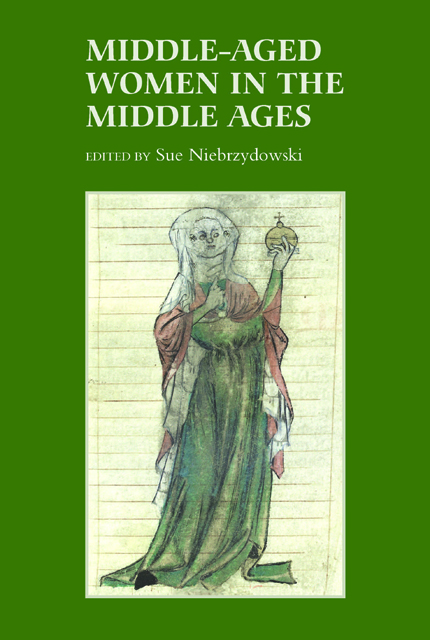Book contents
- Frontmatter
- Contents
- List of Plates
- Abbreviations
- Contributors
- Introduction: ‘Becoming bene-straw’: The Middle-Aged Woman in the Middle Ages
- 1 The Age of Discretion: Women at Forty and Beyond
- 2 Seeking the Middle-Aged Woman in Medieval Wales
- 3 Middle Age in Romance? Magic, Enchantment and Female Power
- 4 Age and Desire in the Old English Life of St Mary of Egypt: A Queerer Time and Place?
- 5 The St Albans Psalter: Sex, Desire and the Middle-Aged Woman
- 6 Speaking Volumes: the Middle-Aged Woman and the Book in Medieval England
- 7 ‘Late hir seye what sche wyl’: Older Women’s Speech and the Book of Margery Kempe
- 8 Preparing for Mature Years: the Case of Margaret of Anjou and her Books
- Select Bibliography
- Index
4 - Age and Desire in the Old English Life of St Mary of Egypt: A Queerer Time and Place?
Published online by Cambridge University Press: 14 February 2023
- Frontmatter
- Contents
- List of Plates
- Abbreviations
- Contributors
- Introduction: ‘Becoming bene-straw’: The Middle-Aged Woman in the Middle Ages
- 1 The Age of Discretion: Women at Forty and Beyond
- 2 Seeking the Middle-Aged Woman in Medieval Wales
- 3 Middle Age in Romance? Magic, Enchantment and Female Power
- 4 Age and Desire in the Old English Life of St Mary of Egypt: A Queerer Time and Place?
- 5 The St Albans Psalter: Sex, Desire and the Middle-Aged Woman
- 6 Speaking Volumes: the Middle-Aged Woman and the Book in Medieval England
- 7 ‘Late hir seye what sche wyl’: Older Women’s Speech and the Book of Margery Kempe
- 8 Preparing for Mature Years: the Case of Margaret of Anjou and her Books
- Select Bibliography
- Index
Summary
Ða eac witodlice se ende his gebedes wæs gefylled, he þa his eagan bewende and þær soðlice man geseah westweardes on þæt westen efstan, and witodlice þæt wæs wifman þæt þær gesewen wæs. Swiðe sweartes lichaman heo wæs for þære sunnan hæto, and þa loccas hire heafdes wæron swa hwite swa wull and þa na siddran þonne oþ þone swuran. (The Old English Life of St Mary of Egypt, 212–18)
[When the end of his prayer was really finished, he turned his eyes and truly he saw there a man hastening westwards in the desert, and really it was a woman who was there seen. Her body was very black because of the heat of the sun, and the hair on her head was as white as wool but no longer than to her neck.]
Let’s face it. We’re undone by each other. And if we’re not, we’re missing something … One does not always stay intact. (Judith Butler, Undoing Gender)
Why is feminism posited as both an embarrassing mother who must be pushed aside and a humorless butch aunt who stands in the way of pursuit of pleasure? Are there other models of generation, temporality, and politics available to queer culture and feminism? (Judith Halberstam, ‘Forgetting Families’)
These three quotations raise interconnected issues that this chapter will address in regard to the queer representations of old age and desire in the Old English Life of St Mary of Egypt, to recognition, relationality, (un)intelligibility and what Butler calls ‘the limits of sexual autonomy’ and to the troubled kinship of feminism with queer studies and its implications for collaborative scholarship. We begin, in our first quotation, with an old woman – or man – in the desert. This leads us to reflect – as our next two quotations suggest – on much larger questions about age, life cycle, time, temporal crossings, and periodisation in relation to both this text and to our own scholarly positions and practices.
The Old English Life of St Mary of Egypt, the earliest of the many medieval vernacular versions of the life of this particular saint, is found in a late-tenth-century collection of saints’ lives, The Lives of Saints, the majority of which are otherwise by Ælfric of Eynsham.
- Type
- Chapter
- Information
- Middle-Aged Women in the Middle Ages , pp. 53 - 68Publisher: Boydell & BrewerPrint publication year: 2011
- 2
- Cited by



